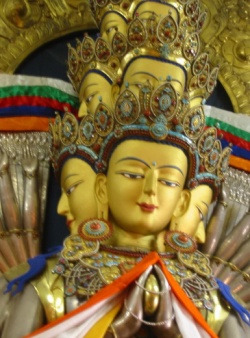Jonang School - Development
The skillful and compassionate Buddha, our Teacher, taught the Three Wheels of Dharma, the First Wheel of the Noble Truths, and the Second Wheel of the Doctrine of Good Discrimination, to his disciples, according to their various mental dispositions and inclinations. Besides this, the Buddha taught Prajnaparamita on Vulture Peak Hill, Kalachakra Root Tantra, and many Mantrayana teachings at Dhanyakaka stupa - specifically, to a group of disciples who were of high mental caliber.
The ancient religion of Tibet is Bon, a Shamanistic religion focused on negotiation with Spirits found in nature. Buddhism replaced Bon in the 7th century, when Buddhist teachings were brought to Tibet from China, Nepal and India. From the perspective of Sutra, from the 7th century up until the 14th century, with great effort and hardship, the Tibetan translators translated the above mentioned doctrines and others taught by the Buddha 2,500 years ago in India (the land of noble beings) and codified them as the standard translation. The Tibetan translations made from Sanskrit are of two types: the translation of the Buddha's words from Sanskrit is known as Kagyur (Bka'-'Gyur), or the Translation of the Buddha's Words, and it consist of more than 100 volumes of texts; and the translation of India masters' commentaries on the Buddha's words is known as the Tengyur (Bstan-'Gyur), or the Translation of Treatises, and it consist of more than 200 volumes of texts.
These translations consist of both Sutras and Tantras. Later, when Buddhism declined in India, the roots of Buddhism were implanted in Tibet, where it was nurtured well. This resulted in the birth of what we presently call the eight great Buddhist schools of Tibet. The fourth amongst the eight Tibetan Buddhist schools, which is well known both in and outside Tibet, is the Jonangpa School. Founded in 1027 A.D., the Jonangpa tradition was further systemized and promoted by Kunkhen Dolpopa Sherab Gyaltsen (1292-1361 A.D), the founder of the Middle-Way School of Extrinsic Emptiness of both Sutra and Tantra. Kungpang Thugje Tsondue (1243-1313 A.D.), the first throne holder of the Jonang School, founded a monastery in Jomonang in U-tsang, and the monastery became known as the Jonangpa monastery (deriving its name from the name of the area). Jonangpa is famous for its instruction and practice of Kalachakra Tantra and differs from other Buddhist schools of thought in its philosophical viewpoint on the nature of reality. Previously, the tradition was known by the name of Kalachakra or "the Followers of the Six Unions".
Kungpang Thugje Tsondu bestowed all the instruction he had, including the instruction on the practice of Six Unions of the Kalachakra, to his successor Jangsem Gyalwa Yeshi (1257-1320 A.D.), the second throne holder of the Jonang School - in the manner of filling a vase to the brim. The latter in turn gave all his instructions to his successor Khetsun Yonten Gyatso (1260-1328), the third throne holder of the Jonang School. These three great figures are known as the Three Initial Lamas of the Jonang School.
Kunkhen Dolpo, the fourth throne holder, a great figure of the Jonang School (who was prophesied in many texts of Sutra and Tantra) with his astounding skill in the field of exposition, debate and composition, made a great contribution towards popularizing the Jonang tradition. He, adhering strictly to the noble practice of the Six Unions of the Kalachakra Tantra, popularized the Jonang doctrine extensively. Furthermore, this holy being introduced the doctrine of Extrinsic Emptiness for the first time in Tibet. He was thus widely known in the whole of Tibet. The doctrine of Extrinsic Emptiness is based solely upon the Buddha's Last Wheel of the Doctrine of Good Discrimination - according to the Ten Sutras in relation to the concept of Tathagatagarbha. This doctrine)] can be expounded through logic and texts. However, the theory of grounds, paths and fruits of the doctrine of [[Others-Emptiness of Madhyamika was established based on the texts such as Uttara Tantra (Unexcelled Continuity), one of the five treatises of Maitreya; Praise of Dharmadatu by Nagarjuna (150-250 A.D.), the founder of the Madhyamika School; the five works on the spiritual stages by Asanga (395-470 A.D.) and the Yum Gsum Gnod 'Joms (Three Consorts) by Vasubandu, the second Buddha.
All Buddhists believe that the basic nature of all phenomena is emptiness. In Tibetan Buddhism the viewpoint of emptiness has two subdivisions: self-emptiness and other emptiness. Most Tibetan Buddhist scholars follow the viewpoint of self-emptiness. However the Jonangpa, founded by Master Dolpopa and strengthened by the eminent Tibetan scholar Taranatha Kunga Nyingpo (1575 - 1635 A.D.), hold to the present day philosophical viewpoint of other-emptiness.
In the land of snow (Tibet), this doctrine of Shentong, or the Extrinsic Emptiness, was supported and practiced by Shakya Chogden, Marpa Lotsawa, Jetsun Milarepa, Kongtrul Yonten Gyatso, Situ Panchen Choekyi Jungne, successive reincarnations of Karmapa, and many great masters of Kagyue School - as well as the great translators Vairochana, Panchen Vilamitra, Kunkhen Longchen Rabjampa. Moreover, Ju Mipham Jamyang Namgyal spread the Lion's Road Proclaiming Extrinsic Emptiness and Dispelling the Doubts of Dharma (Dam Chos Gogs Sel). Amongst the followers of the Gelug tradition, Jamyang Choeje, the founder of Drepung monastery, was a well known proponent of this doctrine of Intrinsic-Emptiness based primarily on the Second Wheel of Dharma - that is, the doctrine of lack of characteristics. As regards the difference between the Intrinsic Emptiness and the Extrinsic Emptiness, the former asserts all phenomenons are not only imputed by thoughts, but are inherently non-existent. The Madhyamika School that adheres to this philosophy is called Prasangika Madhyamika. On the other hand, Shentong, or the Extrinsic Emptiness states that phenomena are intrinsically not empty, but extrinsically empty in relation to the outer phenomenon. The school that accepts the profound philosophy of Shentong is called Yogacara Madhyamika.
From the perspective of Tantra, the lineage of Kalachakra Tantra began from Choegyal Dawa Sangpo (Suchandra) and continued until Panchen Dawa Gonpo (Chandrasugta). He in turn passed it on to Dro Lotsawa Sherab Drak. Introducing the Kalachaktra Tantra in Tibet for the first time in the history of Tibetan Buddhism, Dro Lotsawa founded the lineage of Kalachakra Tantra in Tibet, and Kunkhen Jonangpa, or Dolpopa, was the thirteenth holder of his lineage. Later, during the time of Jetsun Taranatha, otherwise known as Kunga Nyingpi ( 1575-1635), the 27th throne holder of Jonang tradition, the view flourished extensively in Tibet, China and Mongolia.
The core of the Jonang tradition is meditation on the Generation Process and the Perfection Process of the Six Yogas of Kalacakra. Today in Tibet, concentrated in the districts of Ngabha, Zamthang, and Golok in the Amdo region, there are more than 60 Jonangpa monasteries supporting approximately 10,000 monks. Comparatively the Jonangpa is smaller and less popularized in the West than other schools of Tibetan Buddhism. The Jonang masters are extremely dedicated and highly trained, both experientially and intellectually, particularly in Kalachakra Tantric system. In the 21 century, the doctrine of Jonangpa is spreading fast all over Tibet, India, Nepal and Mongolia.
"In the land of snow (Tibet), this doctrine of Shentong, or the Extrinsic Emptiness, was supported and practiced by Shakya Chogden, Marpa Lotsawa, Jetsun Milarepa, Kongtrul Yonten Gyatso, Situ Panchen Choekyi Jungne, successive reincarnations of Karmapa, and many great masters of Kagyue School - as well as the great translators Vairochana, Panchen Vilamitra, Kunkhen Longchen Rabjampa. Moreover, Ju Mipham Jamyang Namgyal spread the Lion's Road Proclaiming Extrinsic Emptiness and Dispelling the Doubts of Dharma (Dam Chos Gogs Sel).
Amongst the followers of the Gelug tradition, Jamyang Choeje, the founder of Drepung monastery, was a well known proponent of this doctrine of Intrinsic-Emptiness based primarily on the Second Wheel of Dharma - that is, the doctrine of lack of characteristics. As regards the difference between the Intrinsic Emptiness and the Extrinsic Emptiness, the former asserts all phenomenons are not only imputed by thoughts, but are inherently non-existent. The Madhyamika School that adheres to this philosophy is called Prasangika Madhyamika. On the other hand, Shentong, or the Extrinsic Emptiness states that phenomena are intrinsically not empty, but extrinsically empty in relation to the outer phenomenon. The school that accepts the profound philosophy of Shentong is called Yogacara Madhyamika."[1]


